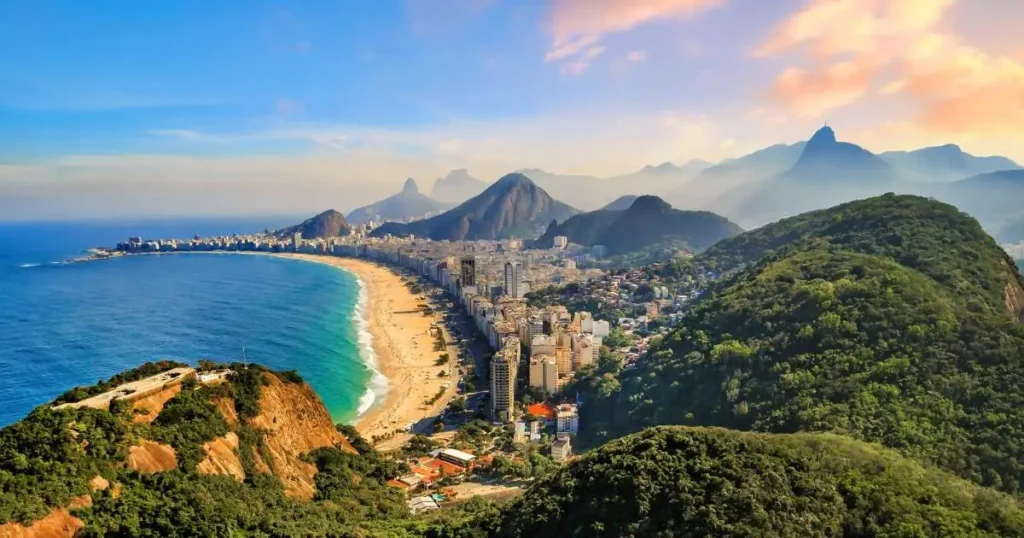Imagine landing in a destination where every step you take contributes to a healthier planet. You deserve a getaway that not only revitalizes your spirit but also respects the environment. In 2025, sustainable travel is more than just a buzzword—it’s a movement toward a greener, more responsible way to explore the world. In this guide, you will discover top eco-friendly destinations, learn what makes a place truly sustainable, and get practical tips to ensure your travel footprint remains as light as possible.
Table of Contents
Why Choose Eco-Friendly Travel in 2025?
You’re not just a traveler; you’re an explorer who cares about the world you visit. With the escalating challenges of climate change and urban congestion, the need for sustainable travel has never been greater. By choosing eco-friendly destinations, you help reduce carbon emissions, support local economies, and promote the preservation of unique cultures and environments.
Consider These Reasons:
- Preserve Natural Beauty: Eco-friendly locations invest in conservation and restoration, ensuring that pristine landscapes and wildlife are protected for future generations.
- Support Local Communities: When you choose green travel options, you help local businesses and artisans thrive, creating sustainable jobs and fostering community pride.
- Innovative Experiences: Many sustainable destinations offer unique experiences—from immersive cultural tours to renewable-energy-powered accommodations—that traditional travel cannot match.
- Reduced Carbon Footprint: Embrace travel methods that favor renewable energy and low-impact transportation, making your journey as responsible as it is memorable.
By opting for sustainable tourism, you actively contribute to a healthier environment while enjoying experiences that enrich your life and leave a positive mark on the places you visit.
Top Eco-Friendly Destinations for 2025
In this section, you’ll explore five outstanding destinations that are leading the charge in eco-friendly travel. Each destination boasts unique attributes and a firm commitment to sustainability.
Costa Rica: The Heart of Pura Vida
Costa Rica remains a shining example of sustainable tourism. As soon as you arrive, you’ll notice the vibrant green landscapes, thriving wildlife, and a strong national dedication to conservation.
Why You Should Visit:
- Lush Rainforests & National Parks: Explore protected areas like Corcovado National Park, where you can witness rare species in their natural habitat.
- Renewable Energy Commitment: Costa Rica’s nearly 100% renewable energy usage means that your visit supports a country that puts the planet first.
- Eco-Resorts & Organic Cuisine: Stay in eco-certified lodges and enjoy meals made with locally sourced, organic ingredients.
Did You Know? Costa Rica’s “Pura Vida” philosophy isn’t just a saying—it’s a way of life. This holistic approach to living translates directly into its travel industry, making it a top destination for those who value nature and sustainability.
Iceland: Land of Geothermal Wonders
Iceland is a destination where the raw power of nature meets innovative sustainability. Its dramatic landscapes, ranging from geysers to glaciers, are maintained with a forward-thinking approach to renewable energy.
Why You Should Visit:
- Geothermal Energy & Hot Springs: Imagine soaking in a natural hot spring heated entirely by geothermal energy while surrounded by a surreal, volcanic landscape.
- Eco-Friendly Infrastructure: Iceland’s transportation and public services are powered by renewable energy sources, reducing the environmental impact of your travels.
- Unique Natural Phenomena: From the mesmerizing Northern Lights to vast lava fields, Iceland offers experiences that are as eco-conscious as they are unforgettable.
Quick Tip: Pack your camera and prepare to capture moments that blend breathtaking beauty with pioneering eco-technology!
Bhutan: The Kingdom of Happiness
Bhutan is a place where progress is measured by happiness rather than gross domestic product. When you travel here, you’re invited to experience a culture that prioritizes well-being, environmental preservation, and cultural heritage.
Why You Should Visit:
- Strict Tourism Policies: Bhutan limits the number of tourists to ensure that each visitor’s impact is minimal, making your journey exclusive and intimate.
- Rich Cultural Heritage: With its beautiful monasteries, fortresses (dzongs), and vibrant festivals, Bhutan offers deep cultural immersion.
- Eco-Conscious Practices: Bhutan is the only carbon-negative country in the world, absorbing more carbon than it produces.
Remember: A visit to Bhutan isn’t just a vacation—it’s an opportunity to reconnect with yourself and the natural world, in a land where sustainability and spirituality walk hand in hand.
New Zealand: Adventure in Harmony with Nature
New Zealand is synonymous with adventure, yet its commitment to preserving the environment makes it a leader in eco-tourism. When you step foot in this island nation, you’ll discover a perfect blend of thrilling activities and sustainable practices.
Why You Should Visit:
- Breathtaking Landscapes: Whether you’re hiking in Fiordland National Park or exploring urban eco-sanctuaries, New Zealand’s diverse terrain offers endless natural beauty.
- Innovative Sustainability Initiatives: From organic vineyards to renewable energy-powered cities, New Zealand sets the standard for sustainable living.
- Outdoor Adventure: If you crave excitement, you can enjoy everything from kayaking and bungee jumping to scenic helicopter rides, all in an environmentally responsible manner.
Insider’s Note: New Zealand’s focus on low-impact tourism means that even high-adrenaline adventures are designed with conservation in mind—so you get your thrill while keeping your footprint small.
Norway: The Fjord Paradise
Norway offers a harmonious blend of pristine nature and modern sustainability. Its awe-inspiring fjords and green urban initiatives make it an ideal destination for those who value both scenic beauty and responsible travel.
Why You Should Visit:
- Stunning Fjords & Natural Scenery: Enjoy cruises along serene fjords powered by hybrid or electric vessels, ensuring you experience nature without compromising the environment.
- Green Urban Living: Cities like Oslo are pioneers in sustainable urban planning, with efficient public transportation, abundant green spaces, and eco-friendly buildings.
- Innovative Eco Initiatives: From electric-powered tours to zero-waste accommodations, Norway continuously introduces new ways to travel sustainably.
Fun Fact: In Norway, you can combine a luxury travel experience with environmental responsibility—many hotels and tour operators have won awards for their sustainable practices, making it a perfect destination for the eco-conscious traveler.
What Makes a Destination Truly Eco-Friendly?
Before you book your next trip, it’s important to understand the elements that contribute to a destination’s eco-friendly credentials. Here’s what to look for:
Key Attributes of Eco-Friendly Destinations:
- Renewable Energy Use: Destinations that use solar, wind, geothermal, or hydroelectric power reduce reliance on fossil fuels.
- Sustainable Infrastructure: Look for eco-lodges, green-certified hotels, and transportation systems that emphasize low emissions and energy efficiency.
- Conservation Efforts: Successful sustainable destinations actively protect natural habitats, support reforestation projects, and promote biodiversity.
- Community Engagement: When local communities benefit from tourism through fair wages, cultural preservation, and community-led initiatives, your travel has a positive social impact.
- Waste Management Practices: Effective recycling programs, minimal single-use plastics, and water conservation measures all contribute to lower environmental footprints.
- Low-Impact Transportation: Destinations with accessible public transportation, bike-friendly cities, or electric vehicle options allow you to explore without leaving a heavy carbon footprint.
When you choose a destination that embodies these values, you’re not just enjoying a vacation—you’re contributing to a global effort to protect our planet.
Comparing Eco-Friendly Destinations: Highlights & Costs
To help you decide which destination best fits your travel style and budget, here’s a comparative look at the top eco-friendly destinations for 2025:
| Destination | Key Highlights | Average Daily Cost (USD) | Sustainability Level |
|---|---|---|---|
| Costa Rica | Rainforests, wildlife tours, renewable energy initiatives, eco-resorts | $150 – $250 | High |
| Iceland | Geothermal spas, renewable energy, natural wonders like the Northern Lights and volcanic landscapes | $200 – $300 | Very High |
| Bhutan | Monasteries, cultural festivals, low tourist density, carbon-negative policies | $180 – $280 | High |
| New Zealand | Diverse landscapes, adventure sports, organic vineyards, eco-friendly urban innovations | $170 – $270 | High |
| Norway | Fjord cruises, green urban planning, electric tours, pristine nature | $220 – $320 | Very High |
How to Use This Table:
- Budget Considerations: If cost is a major factor for you, compare the daily expenses and choose a destination that fits your financial plan.
- Sustainability Level: Decide how much emphasis you want on sustainability. While all these destinations are eco-friendly, some, like Iceland and Norway, lead the pack in renewable energy and green urban practices.
- Experience Type: Are you seeking adventure, cultural immersion, or a luxurious retreat? The table gives you a quick snapshot to match your travel desires with the destination’s offerings.
For more ideas on affordable adventures, check out our Budget Solo Travel in 2025: Top Tips & Destinations.
Your Essential Eco Travel Tips for 2025
When planning an eco-friendly vacation, you want to ensure that every aspect of your journey aligns with sustainable practices. Here are some expert tips to make your travel both enjoyable and environmentally responsible:
Pre-Trip Planning
- Research & Book Eco-Certified Accommodations: Look for hotels and resorts that have certifications from reputable organizations. This means they follow strict guidelines for energy efficiency, waste management, and community engagement.
- Plan for Low-Impact Transportation: Prioritize destinations with robust public transit systems, or consider renting an electric vehicle. Use local bike rentals or walking tours to reduce your carbon footprint.
- Check Travel Reviews: Look for traveler feedback that mentions eco-friendly practices. Reviews can provide insights into how well a destination or service performs in terms of sustainability.
On the Ground
- Support Local Businesses: Choose to eat at local restaurants, purchase handmade goods, and use local guides. This not only supports the community economically but also preserves cultural traditions.
- Minimize Single-Use Items: Bring reusable water bottles, bags, and utensils. Reducing waste is one of the simplest ways to lessen your environmental impact.
- Be Mindful of Nature: Stick to designated trails, respect wildlife, and follow all park guidelines. The less you disturb natural habitats, the better your eco-friendly travel credentials.
- Engage with Locals: Ask about local conservation initiatives and ways you can contribute. Sometimes, a small donation or volunteering a few hours can make a big difference.
While Traveling
- Stay Informed: Use apps and websites that provide real-time information on environmental practices and local guidelines. This will help you adapt your travel plans if necessary.
- Track Your Carbon Footprint: Some online tools allow you to calculate the emissions from your travel and offset them through reforestation projects or renewable energy credits.
- Share Your Experience: Document your journey on social media or your personal blog. By sharing your eco-friendly travel story, you inspire others to consider sustainable options.
Post-Trip Actions
- Provide Feedback: Leave reviews highlighting the eco-friendly features of your stay and travel experiences. Your input can help other travelers make informed decisions.
- Offset Carbon Emissions: Consider donating to environmental projects that focus on reforestation or renewable energy. Even small contributions can help counterbalance your travel impact.
- Reflect on Your Journey: Think about what worked well and what could be improved next time. Sustainable travel is an ongoing journey, and every trip is an opportunity to learn and do better.
Frequently Asked Questions
Q: What exactly makes a destination eco-friendly?
A: An eco-friendly destination uses renewable energy, implements sustainable infrastructure, actively conserves natural habitats, supports local communities, practices efficient waste management, and provides low-impact transportation options.
Q: How can I ensure that my vacation is environmentally responsible?
A: You can do so by researching and booking eco-certified accommodations, using sustainable transportation options, supporting local businesses, minimizing waste through reusable items, and offsetting your carbon emissions with trusted organizations.
Q: Are eco-friendly vacations more expensive?
A: Not necessarily. While some eco-certified options might cost slightly more, many destinations offer competitive pricing. Moreover, investing in sustainable travel contributes to long-term environmental benefits and can sometimes even reduce costs through efficient resource use.
Q: How do sustainable travel practices benefit local communities?
A: Sustainable practices ensure that tourism supports local economies by creating jobs, preserving cultural heritage, and investing in community development. When you support local businesses and conservation efforts, you help maintain the unique charm of a destination while fostering economic resilience.
Q: What can I do if I want to reduce my travel carbon footprint?
A: Look for destinations with strong public transit systems or bike-friendly cities, choose eco-certified accommodations, and consider offsetting your travel emissions through reputable programs. Every small change—from packing reusable items to supporting local conservation projects—helps lower your overall impact.
Final Thoughts & Call-to-Action
Your journey toward eco-friendly travel begins with a single, mindful decision. By choosing destinations like Costa Rica, Iceland, Bhutan, New Zealand, or Norway, you’re not only treating yourself to extraordinary adventures—you’re also joining a global effort to make travel sustainable and responsible. Every step you take, every meal you enjoy, and every local business you support contributes to a brighter, greener future for our planet.
Now is the time to redefine your travel experiences:
- Embrace the green revolution in travel.
- Plan your next eco-adventure with confidence.
- Share your sustainable journey with friends and inspire change.
Your future trips can be more than just escapes—they can be meaningful contributions to a healthier world. Don’t wait; start planning your eco-friendly getaway today and experience the joy of responsible travel.
Ready to take the next step?
Book your eco-friendly vacation now, join online communities for sustainable travelers, or subscribe to our newsletter for the latest tips and updates on green travel trends. Every action you take is a step toward preserving the beauty of our world for future generations.
By integrating these strategies, you ensure that every word in your travel narrative not only informs and inspires but also positions your website as a trusted resource for sustainable travel in 2025. Your passion for responsible tourism shines through, inviting your readers to embark on journeys that are as rewarding for them as they are beneficial to the planet.
Remember, when you travel green, you’re not just a visitor—you’re a guardian of nature. Enjoy the adventure, make every moment count, and lead the way in sustainable exploration.
For more details on global eco-certifications, visit the World Tourism Organization’s Sustainability page.
Embrace a future of travel where you’re at the forefront of a movement that cares—for you, for local communities, and for our shared planet. Your journey to a greener tomorrow begins now.




